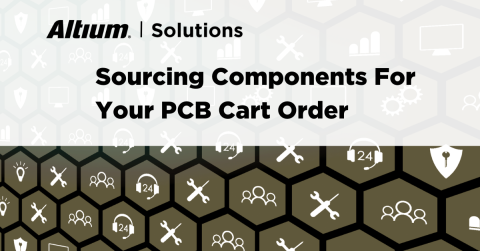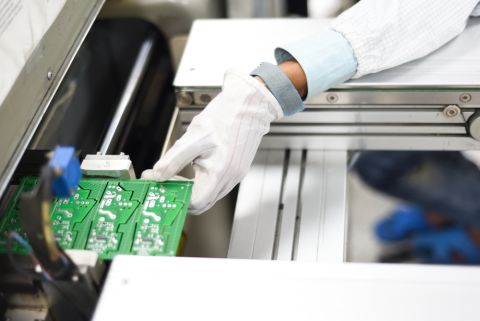Real-Time PCB Components List Management with Altium Designer

Plainly stated, the choice of components that you select will determine the functionality, reliability, and manufacturability of your PCB. Choosing the wrong components is akin to arriving at the construction site with the wrong materials. Either the structure cannot be built at all or it will ultimately fail prematurely. The use of a PCB design package with good component management capability can help you select a PCB component list that will ensure your printed circuit board operates as intended throughout its normal lifecycle.
ALTIUM DESIGNER
Altium Designer’s real-time BOM makes it easy to select and manage your PCB components list throughout the product lifecycle.
Good PCB layout design includes making sure there is a place for every component. Good product management includes making sure there is a component in its place throughout the lifecycle of your product. Developing the PCB component list is usually the first step during schematic design and PCB design primarily consists of laying out the structure such that the selected components are connected properly. How well this is done determines whether your design can be manufactured, how well your board performs its intended function, and the reliability of your circuit board.
Selecting Components for Functionality and Reliability
When composing your PCB component list, the primary concern is typically whether the component meets your functionality requirements. This is followed by determining what are the components of a PBC that should be prioritized for use in the design. For example, through-hole, surface mount devices (SMDs), or embedded components. Your choice of component type has a significant impact on the PCB manufacturing process and should be incorporated into your PCB component list selection. The manufacturing concerns along with component security are major factors for your product’s reliability.
Optimizing PCB Component List Selection using Altium Designer Active BOM
The integration of functionality, manufacturing, security, and reliability concerns into your PCB components list creation requires knowledge about component capability, availability, and supply chain. With Altium Designer’s Active BOM you can access real-time data and information from multiple suppliers enabling you to compare components and optimize your selections.
- Deciding between through-hole, SMD, and embedded component type should be based upon an understanding of the advantages and disadvantages of each for functionality, manufacturability, and security.
Learn about the advantages and disadvantages of using embedded components.
- Using counterfeit components is a growing problem that you should address for your PCB component list selections.
Learn how to avoid counterfeit components in your design.
Encountering a component shortage can bring your production and distribution to an abrupt halt and may lead to redesign and development. Knowing how to avoid planned outages, such as obsolescence, can help mitigate this problem.
Learn how to account for component obsolescence during design.
- Real-time management of your component data and information is necessary throughout the lifecycle of your product.

Component selection with real-time data
Designing the PCB Layout of Components for Manufacturability
Irrespective of how good a design may appear or perform during simulation it ultimately must be built. This means defining footprint pads, pad spacing, surface element clearances, traces, drill holes (mounting and vias), and other PCB board parameters such that your contract manufacturer (CM) is able to manufacture your board. The utilization of rules and guidelines based upon your CM’s equipment capabilities and processes is known as design for manufacturing (DFM) and Altium Designer makes it easy to implement using the Design Rule Checker (DRC), shown below.

Setting DRC based on CM DFM
Incorporating DFM for Component Layout using Altium
The number of specifications that can be set using the DRC in Altium is extensive. Moreover, these choices are categorized according to their intent, as shown in the figure above, which makes it simple to identify and set parameters for DFM. Altium also allows you to define custom rules which may be used in a hierarchical rule-based structure to ensure that you avoid manufacturability issues, including damaged components and inadequate solder masking.
- Damaged components may be a result of component manufacture, the PCB manufacturing process, or poor design. For example, a component may be warped during reflow during PCB assembly due to inadequate thermal dissipation design.
- The solder mask protects your circuit board from damage from external sources, such as air which may cause oxidation and handling damages. The silkscreen is important for the assembly of your board as it helps to ensure that component locations can be easily identified and parts are properly placed and oriented. Without adequate solder mask clearance silkscreen markings may be covered or removed during soldering.
Learn how to set and check solder mask clearances with silkscreen markings.
- DFM can be used most effectively if you understand how your design choices impact your board’s manufacture.
- Learn how your design choices impact the manufacturability of your PCB design.
Managing Components throughout the Product Lifecycle
Although the creation of your PCB components list occurs during design, you must consider its impact on the manufacturing and production stages of your product’s lifecycle. Not doing may cost you an increased turnaround time for manufacturing and interruption in distribution to your customers.
Using Active BOM to Stay Up to Date on the Status of Your PCB Component List

Real-time component data with Active BOM
Altium Designer’s Active BOM, shown in the figure above, gives you access to real-time supplier data and information for your products that enables you to predict potential component shortages and avert any interruption in manufacturing and production. This capability coupled with the advantages for initial component selection makes Active BOM the premier tool for real-time PCB components list management.
- Access to real-time data allows you to make the best component selections for your design.
Learn about accessing supplier data to optimize your component selection.
- One way to guard against component shortages is to ensure there are alternative parts available if needed.
- To enhance your component selection Altium Designer has advanced features for component searches.
PCB components listing generation involves much more than simply choosing parts that will meet your performance and functionality goals. You must also consider whether your components can be arranged and interconnected such that your design can be manufactured and whether adequate numbers of components are and will be available to meet your production needs. Incorporating these aspects into your PCB component list generation strategy necessitates management of your BOM.
In Altium Designer’s Active BOM you have a tool that provides you real-time supplier data that allows you to:
- Accurately predict future part longevity with historical lifecycle data.
- Attain real-time pricing and availability from trusted suppliers.
- Improve supply chain with verified alternate components.









